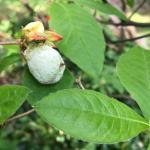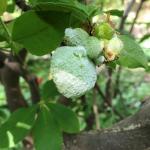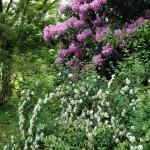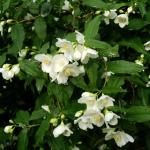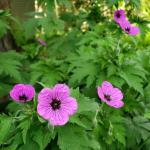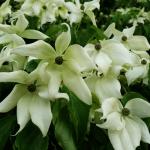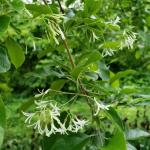UMass Extension's Landscape Message is an educational newsletter intended to inform and guide Massachusetts Green Industry professionals in the management of our collective landscape. Detailed reports from scouts and Extension specialists on growing conditions, pest activity, and cultural practices for the management of woody ornamentals, trees, and turf are regular features. The following issue has been updated to provide timely management information and the latest regional news and environmental data.
To read individual sections of the message, click on the section headings below to expand the content:
Scouting Information by Region
Environmental Data
The following data was collected on or about June 5, 2019. Total accumulated growing degree days (GDD) represent the heating units above a 50° F baseline temperature collected via our instruments for the 2019 calendar year. This information is intended for use as a guide for monitoring the developmental stages of pests in your location and planning management strategies accordingly.
|
MA Region/Location |
GDD |
Soil Temp |
Precipitation |
Time/Date of Readings |
||
|
1-Week Gain |
2019 Total |
Sun |
Shade |
|||
|
CAPE |
51 |
253 |
65 |
58 |
0.44 |
12:00 PM 6/5 |
|
SOUTHEAST |
81 |
319.5 |
59 |
55 |
0.5 |
12:45 PM 6/4 |
|
NORTH SHORE |
74.5 |
317.5 |
59 |
54 |
0.22 |
10:00 AM 6/5 |
|
EAST |
75 |
361 |
68 |
61 |
0.47 |
5:00 PM 6/5 |
|
METRO |
66 |
326.5 |
62 |
58 |
0.37 |
6:00 PM 6/4 |
|
CENTRAL |
89 |
360.5 |
49 |
54 |
0.42 |
1:05 PM, 6/4 |
|
PIONEER VALLEY |
82 |
375 |
61 |
57 |
0.25 |
11:00 AM 6/4 |
|
BERKSHIRES |
72 |
328 |
63 |
54 |
1.23 |
8:30 AM 6/5 |
|
AVERAGE |
74 |
330 |
61 |
56 |
0.49 |
- |
n/a = information not available
Phenology
| Indicator Plants - Stages of Flowering (BEGIN, BEGIN/FULL, FULL, FULL/END, END) | ||||||||
|---|---|---|---|---|---|---|---|---|
| PLANT NAME (Botanic/ Common) | CAPE | S.E. | N.S. | EAST | METRO W. | CENT. | P.V. | BERK. |
|
Kalmia latifolia (mountain laurel) |
* |
Begin |
Begin |
Begin |
* |
* |
Begin/Full |
* |
|
Chionanthus virginicus (fringe tree) |
* |
Full |
Begin |
Begin |
Begin |
Begin/Full |
Begin/Full |
Full |
|
Cornus kousa (kousa dogwood) |
* |
Begin |
Begin |
Begin |
Begin |
Begin |
Begin/Full |
Begin/Full |
|
Robinia pseudoacacia (black locust) |
* |
Begin/Full |
Begin/Full |
Begin/Full |
Begin/Full |
Begin/Full |
Full |
Begin/Full |
|
Kolkwitzia amabilis (beautybush) |
Begin |
Full |
Begin |
Begin/Full |
Begin/ Full |
Begin |
Full |
Begin/Full |
|
Weigela florida (old fashioned Weigela) |
Full |
Full |
Begin/Full |
Begin/Full |
Begin/ Full |
Begin/Full |
Full |
Begin/Full |
|
Deutzia spp. (Deutzia species) |
Begin/Full |
Full |
Full |
Full |
* |
Full |
* |
Full |
|
Enkianthus campanulatus (redvein Enkianthus) |
* |
Full |
Full |
Full |
Full |
Full |
Full |
Full |
|
Rhododendron carolinianum (Carolina Rhododendron) |
Full/End |
Full |
Full/End |
Full/End |
Full/End |
Full/End |
Full |
Full |
|
Rhododendron catawbiense (Catawba Rhododendron) |
Full |
Full |
Full/End |
Full/End |
Full/End |
Full |
Full |
Full |
|
Aesculus hippocastanum (common horsechestnut) |
Full/End |
Full/End |
Full/End |
Full/End |
Full/End |
Full/End |
Full/End |
Full/End |
|
Spiraea x vanhouttei (Vanhoutte Spirea) |
Full/End |
Full/End |
Full |
* |
Full/End |
Full |
Full/End |
Full |
| * = no activity to report/information not available | ||||||||
Regional Notes
Cape Cod Region (Barnstable)
General Conditions: The average temperature from May 29 – June 5 was 58˚F with a low of 45˚F on June 4 and a high of 73˚F on June 3. Just under a half inch of precipitation fell during the period. Overall the period was sunny and dry. Topsoil moisture is short, subsoil moisture is adequate.
Pests/Problems: Winter moth has mostly migrated to the soil to pupate. Lecanium scale females have begun laying eggs and are easier to see now that they have obtained their hemispherical helmet shape. Damage to oaks from lecanium scale is being seen primarily in the form of twig dieback. Honeydew is heavy in areas where populations are high. Large populations have also been observed on sweetgum and black gum. Other insects or damage seen over the past week include sawfly larvae on oak, sawfly larvae on rose, Viburnum leaf beetle larvae on Viburnum, Hydrangea leaftier on H. arborescens, boxwood psyllid and boxwood leafminer on boxwood, and lily leaf beetle on Asiatic lily. Disease symptoms or signs seen over the past week include brown rot on Prunus spp., anthracnose on sycamore, anthracnose on dogwood, winter burn on white pine and black spot on rose. Cedar apple rust was still active during the beginning of the period, red thread was seen on turf and normal spring leaf drop in Ilex species. Slugs and earwigs are active. Weeds in bloom include black medic (Medicago lupulina), cypress spurge (Euphorbia cyparissias), white clover (Trifolium repens), hawkweed (Hieracium pratense) and cinquefoil (Potentilla simplex).
Southeast Region (New Bedford)
General Conditions: Seventy-degree days are here; it feels like a big switch over from spring into early summer this week. Many tulips are being pulled and summer annuals are being planted. The evening temperatures are still dropping into the low 50’s and the days have been windy, reminding us that spring is indeed still here. So far this week we have received half of an inch of rain with more in the forecast for the remainder of the week. Cornus kousa is beginning to bloom, Chionanthus spp. are blooming, and many of the Rhododendrons are in full bloom.
Pests/Problems: Slug damage has been spotted and tent caterpillars are present. Garlic mustard, cress, and creeping fig are going to seed. Chipmunks, turkeys, groundhogs, rabbits, mosquitos, and deer are active in the gardens. Many grubs have been noted in gardens and lawns. See the insect section for further details on winter moth.
Attention Southeast region readers: Would you be a good scout for the Landscape Message? UMass Extension is seeking a capable individual to take over reporting duties for the Southeast region starting ASAP. Candidates must be able to scout and report weekly through June, bi-weekly through July, August, and September, and monthly in October, November, and December. Ideally this person would be located in roughly the Brockton-Bridgewater-Taunton area (or able to regularly scout that area), although we will entertain inquiries from throughout Bristol and Plymouth Counties. The scouting and reporting for each message is estimated to take approximately 1/2 day per message week, and UMass Extension is able to pay a stipend for scouts. If interested, see the "Description of Responsibilities" here: https://ag.umass.edu/sites/ag.umass.edu/files/content-files/alerts-messages/2018_scout_expectations.pdf then contact Ellen Weeks at weeks@umass.edu or 413-545-2685 to apply.
North Shore (Beverly)
General Conditions: There was a shift in the weather during the first part of this reporting period. Cool spring-like weather was replaced by warm early summer-like weather with sunny or overcast skies. Day temperatures were in the mid-60s to low 70s. Night temperatures were in the low to mid 50s. Approximately 0.22 inches of rain was recorded at Long Hill. Due to moist soil and cool weather, grass is looking good on lawns. Woody plants seen in bloom include: Chinese Neillia (Neillia sinensis), Wisteria (Wisteria floribunda), tree Wisteria (Wisteria longissima alba), slender Deutzia (Deutzia gracilis), fringe tree (Chionanthus virginicus), doublefile Viburnum (Viburnum plicatum var. tomentosum), redvein Enkianthus (Enkianthus campanulatus), little leaf lilac (Syringa microphylla), beautybush (Kolkwitzia amabilis), Kousa dogwood (Cornus kousa), mock orange (Philadelphus spp.),sapphire-berry (Symplocos paniculata), mountain laurel (Kalmia latifolia), Vanhoutte Spirea (Spiraea x vanhouttei), Weigela (Weigela florida), and some azalea varieties. Some of the non-woody plants seen in bloom include: fetterbush (Leucothoe fontanesiana), Scotch rose (Rosa spinosissima), Peony (Paeonia spp.), Cranesbill (Geranium spp.), bleeding heart (Dicentra spectabilis), Solomon’s seal (Polygonatum odoratum), blue star (Amsonia hubrichtii), fleece plant (Persicaria amplexicaulis), and several annuals.
Pests/Problems: Galls of azalea leaf and flower gall (Exobasidium vaccinii) are starting to develop the white spore layer. Prune them off immediately and discard them in the trash. Viburnum leaf beetles continue to enlarge and are causing serious damage on American cranberrybush Viburnum. The leaves are almost completely skeletonized. Arrowwood Viburnum is also slightly affected. Other Viburnum cultivars are not affected. Invasive plant species observed in flower include autumn olive (Elaeagnus umbellata) and burning bush (Euonymus alatus). Weeds observed in flower include: dandelion (Taraxacum officinale), ground ivy (Glechoma hederacea), garlic mustard (Alliaria petiolata), deadnettle (Lamium purpureum), common chickweed (Stellaria media) and common groundsel (Senecio vulgaris). Mosquitoes and ticks are very active. Protect yourself with a repellent when working outdoors.
East Region (Boston)
General Conditions: We finally experienced a series of seasonable days. High temperatures ranged from 52.4˚F to 73.2˚F, averaging 67.5˚F. Low temperatures ranged from 44.7˚F to 55.1˚F averaging 50.3˚F. We are at a total of 361 GGDs base 50˚F. We received 0.47” of precipitation over the past seven days. We ended May with a total of 3.65” having received precipitation on 18 of 31 days. Plants in bloom include: Chionanthus retusus (Chinese fringetree), Chionanthus virginicus (fringetree), Clematis cultivars, Deutzia gracilis ‘Nikko’ (slender Deutzia), Deutzia scabra ‘Pink Minor’ (fuzzy Deutzia), Hydrangea anomala subsp. petiolaris (climbing Hydrangea), Liriodendron tulipifera (tulip tree), Paeonia spp. (peony), Rosa rugosa (beach rose), Rosa glauca (redleaf rose) and Wiegela spp. Monarchs and a variety of other butterflies have been active throughout the landscape.
Pests/Problems: Japanese knotweed (Fallopia japonica) is two to three feet tall in unmanaged areas. Black swallow-wort (Cynanchum louiseae) is winding its way up available plants. Creeping buttercup (Ranunculus repans) continues to flower. Viburnum leaf beetle larvae are large and skeletonizing susceptible Viburnum spp. foliage. Boxwood psyllid (Psylla buxi) are active. Spittlebug has been observed on lavender. Aphids are feeding on birch foliage
Metro West (Acton)
General Conditions: At last, we experienced some late spring-like weather with scattered rain mixed in with warm and windy days. Wind gusts were recorded at 20 mph and a high temperature of 80°F was recorded on both June 1st and 2nd. Rainfall fell short last month for the monthly May average but not by much. The average is 4.04” and 3.75” of rain was recorded. For the month of June, the average monthly rainfall is 3.93” and so far I have recorded 0.37” of rain, but there is plenty of time to make up the difference. Much is in bloom at this time of the year, including the following woody plants: Aesculus hippocastanum (horsechestnut), Chionanthus retusus (Chinese fringe tree), C. virginicus (fringe tree), Cornus florida (dogwood), C. kousa (kousa dogwood), C. x rutgersensis 'Ruth Ellen' (Rutgers hybrid dogwood), Cornus sericea (red twig dogwood), Cotinus coggygria (common smokebush), Crataegus spp. (hawthorn), Kerria japonica (Japanese Kerria), K. japonica ‘Pleniflora’ (double flowered Japanese Kerria), Kolkwitzia amabilis (beautybush), Laburnum x watereri (golden chain tree), Leucothoe axillaris (coast leucothoe), Prunus serotina (black cherry), Robinia pseudoacacia (black locust), Rhododendron spp. (Rhododendron/azalea), Rosa spp. (rose), R. rugosa (rose), R. 'Knockout' (knockout family of roses), Rubus spp. (blackberry, bramble, raspberry), Spiraea spp. (bridal wreath), Syringa spp. (late blooming lilac), Viburnum plicatum var. tomentosum (doublefile Viburnum), and V. sargentii (Sargent Viburnum). Woody vines in bloom are: Aristolochia macrophylla (Dutchman’s pipe), Clematis spp. (clematis), Lonicera sempervirens (trumpet honeysuckle), and Wisteria spp. (Wisteria).
Contributing even more color and interest to the landscape are some flowering herbaceous plants and spring ephemerals including: Ajuga reptans (bugleweed), Alchemilla mollis (lady’s mantle), Allium spp. (ornamental flowering onion), including A. giganteum (giant onion),and A. schoenoprasum (chives), Amsonia hubrichtii (Arkansas blue star), Aquilegia vulgaris (columbine), Aurinia saxatilis (basket of gold), Baptisia australis (false blue indigo), Chrysogonum virginianum (green and gold), Convallaria majalis (lily of the valley), Dianthus deltoides (maiden pink), Dicentra eximia (fringed bleeding heart), D. spectabilis (old fashioned bleeding heart), D. spectabilis 'Alba' (white flowering old fashioned bleeding heart), Dictamnus albus (gas plant), Gallium odorata (sweet woodruff), Geranium maculatum (wild Geranium), G. macrorrhizum (bigroot Geranium), G. sanguineum (bloody cranesbill), Hemerocallis spp. (early flowering daylily), Heuchera spp. (coral bells), Hyacinthoides hispanica (wood hyacinth), Iberis sempervirens (evergreen candytuft), Iris cristata (crested Iris), I. germanica (bearded Iris), I. sibirica (Siberian Iris), Lupinus 'Russell Woodfield Hybrids' (lupine), Nepeta spp. (ornamental catmint), Paeonia spp. (peony), Papaver orientale (Oriental poppy), Phlox x subulata (moss Phlox), P. divaricata (Canadian Phlox), P. stolonifera (creeping Phlox), Polemonium reptans (Jacob’s ladder), Primula spp. (primrose), Salvia nemerosa (Salvia), Saponaria ocymoides (rock soapwort), Thymus praecox (thyme), Veronica umbrosa 'Georgia Blue' (speedwell), Vinca minor (periwinkle), and Viola spp. (violet).
Pests/Problems: Consistent winds and gusts have brought down tree limbs, large and small. Gypsy moth caterpillar feeding is minimal. Ticks and mosquitoes are out in full force and are actively feeding. Many of our most invasive plants have flowered and are beginning to set seed. Those include: Alliaria petiolata (garlic mustard), Berberis thunbergii (barberry), Elaeagnus umbellata (autumn-olive), Euonymous alatus (burning bush) and Rhamnus cathartica (common buckthorn).
Central Region (Boylston)
General Conditions: It’s a great time of year for flowering plants in the garden. Peonies and Irises exploded this week. Enkianthus campanulatus (redvein enkianthus) looks stunning and the fragrance of both Philadelphus (mockorange) and Zabelia tyaihyonii (formerly Abelia mosanensis, glossy Abelia) is nearly as impressive as their blossoms. Cornus kousa (Korean dogwood) and its cultivars are just coming into bloom. Because the “flower petals” we see are actually bracts (modified leaves), this species can flower reliably for a long period of time. Korean dogwood flowers are followed by large edible fruits in mid- to late-summer. The rains have slowed and we’ve begun to see warmer and more humid summer-like temperatures.
Pests/Problems: Some of those fungal pathogens that we had suspected the abundant spring rains would bring us have begun to show. Lilacs are the first to show signs of powdery mildew this spring. Many of the peonies are showing fungal leaf spot. Columbines are being hit with columbine sawfly and we’ve seen a bit of hibiscus sawfly. Gypsy moth is far less severe than the few previous years. Lots of small holes in susceptible tree leaves, but no defoliation like we experienced each of the last three or four seasons. Mosquitoes have been terrible.
Pioneer Valley Region (Amherst)
General Conditions: Another week of varying temperatures in the Pioneer Valley with highs ranging from 64°F to 82°F and lows spanning 45°F to 60°F. We continue to oscillate between warm and sunny days back to cool and windy days. Soil temperatures are still hovering in the upper 50s to lower 60s and are becoming dry in some full-sun settings with the lack of significant rainfall over the past week. While scattered thunderstorms rolled through the region on Sunday, 6/2, they primarily occurred in northern Hampshire and Franklin Counties, missing the southern half of the valley. After an extremely wet month of April, many weather stations recorded less than 3ʺ of rain during May. According to the Northeast Regional Climate Center, temperatures were slightly cooler than average during our fifth month of the calendar year, especially in early May. Gusty winds were once again a dominant feature of this past reporting period. Sustained winds of 10–20 mph with gusts up to 30 mph were recorded on Sunday, 6/2 and Monday, 6/3 at Barnes Airport in Westfield. Giant, flower-packed Rhododendrons are on full display right now in the valley along with several other flowering trees and shrubs. The landscape still appears lush and green as we settle into summer. The long-term forecast calls for steadily warmer temperatures so ensure that recent transplants are receiving adequate irrigation before the real heat and humidity of summer develops.
Pests/Problems: Apple scab can be readily observed on crabapple and apple trees in the landscape. The diffuse, dark brown spots and blotches are spread throughout the upper surface of the leaves. To date, only minimal leaf shedding has been observed but will build as the disease advances over the course of the season. Damage from gypsy moth continues to be minor for most infested trees at this time, which is great news. There are exceptions, of course, with destructive feeding damage observed on apple in the Amherst area. Oak anthracnose can be readily observed, mostly on lower canopy foliage receiving partial shade. American sycamore appears to be finally overcoming the spring anthracnose assault, flushing new leaves and shoots that are elongating and filling out the canopy. A myriad of green-colored caterpillars can be found feeding and rolling leaves of various deciduous trees and shrubs in the landscape. For young and recently transplanted hardwoods, scout for evidence of leaf feeding and rolling. Carefully unfurl rolled leaves to capture the caterpillars before they retreat and drop to the ground to avoid predation. We can also readily find leaf galls from eriophyid mites and aphids on a range of deciduous hardwoods. Treatment can commence for destructive and invasive armored scale insects, especially the elongate hemlock scale. Eastern hemlock is a keystone species and deserves protection against invasive pests in both landscape and forest settings. Deer browse has been observed on tender new growth of yew and arborvitae. Deer will often “scout” feeding sites during the summer for the lean weeks of late winter and early spring when food is scarce. Protect new growth with repellents to deter their return. Consider fertilization for woody shrubs injured by cold temperatures and wind during this past winter.
Berkshire Region (Great Barrington)
General Conditions: For the third week in a row, some rain fell on 5 of the past 7 days (May 29 – June 4). As a result, soil moisture continues to be high. However, wind, bright sun and temperatures in the upper 70s on the morning and early afternoon of June 5 promoted some drying of at least the surface inch of soil. Farmers have picked up the pace of tilling soils and planting corn despite the high moisture content. Good planting conditions for ornamental plants remain as little to no watering is needed following planting. Temperatures for most of the week were in the 70s in the daytime and 50s during the nights. The one oddity was on the morning of June 4 when the temperatures at the Pittsfield Airport dropped to 39˚F and in West Stockbridge to 37˚F at 6 AM. Plant development continues at a steady pace but the bloom time of some early flowering shrubs, e.g. lilacs, has been extended. Turfgrass growth is rapid in response to moist soil and warming temperatures.
Pests/Problems: Deer ticks abound. Almost everyone I’ve spoken to has had at least one tick attachment. Based on earlier projections and current experiences, it behooves everyone working or playing outdoors around live or dead vegetation to take all precautions to protect themselves from ticks. As expected with the wet weather and warming temperatures, mosquitoes are very active and the populations are very high. Wasps, snails, slugs, millipedes, ants, and various gnats are active. Browsing by deer, rabbits, woodchucks, and voles continues to be a problem in managed landscapes. Reports of winter damaged or killed vegetation continue to come in. Most affected are needled and broadleaf evergreens but a surprising number of deciduous trees and shrubs are dead or have significant dieback. Viburnums, Deutzias, and Perotia were among the affected plants observed this week. Despite moist weather, not many foliar diseases have yet been seen. The most common foliar diseases now are apple scab and cedar apple rust; some leaf drop on infected crabapples can already be seen. Wilting of shoots of ‘Black Lace’ Sambucus was found at one site but examination and dissection of the twigs did not reveal any borers - a frequent cause of wilting of elderberry (Sambucus) shoots. Eastern tent caterpillars have dropped from trees and can be seen crawling on the ground as they seek sites on which to spin their cocoons. Boxwood leaf miner (pupae and adults), Viburnum leaf beetle (larvae), and imported willow leaf beetle (larvae) are active. Signs of feeding by lily leaf beetles were found on foliage of Oriental lilies but neither adults nor larvae were observed at this time.
Regional Scouting Credits
- CAPE COD REGION - Russell Norton, Horticulture and Agriculture Educator with Cape Cod Cooperative Extension, reporting from Barnstable.
- SOUTHEAST REGION - Kristin McCullin, Horticulturist reporting from Haskell Public Gardens, New Bedford.
- NORTH SHORE REGION - Geoffrey Njue, Green Industry Specialist, UMass Extension, reporting from the Long Hill Reservation, Beverly.
- EAST REGION - Kit Ganshaw & Sue Pfeiffer, Horticulturists reporting from the Boston area.
- METRO WEST REGION – Julie Coop, Forester, Massachusetts Department of Conservation & Recreation, reporting from Acton.
- CENTRAL REGION - Mark Richardson, Director of Horticulture reporting from Tower Hill Botanic Garden, Boylston.
- PIONEER VALLEY REGION - Nick Brazee, Plant Pathologist, UMass Extension Plant Diagnostic Lab, reporting from UMass Amherst.
- BERKSHIRE REGION - Ron Kujawski, Horticultural Consultant, reporting from Great Barrington.
Woody Ornamentals
Diseases
Recent pests and pathogens of interest seen in the UMass Extension Plant Diagnostic Lab https://ag.umass.edu/services/plant-diagnostics-laboratory:
Sycamore anthracnose, caused by Apiognomonia veneta, on London planetree (Platanus x acerifolia). The tree is >20-years-old and resides in full sun with drip irrigation. In May, shoot tip wilt and dieback was observed and the symptoms have appeared in previous years. While London planetree is generally more resistant to sycamore anthracnose compared to American sycamore, planetree is susceptible to infection. As conditions become warmer in June the tree should be able to leaf out and produce a full canopy.
Dothistroma needle blight, caused by Dothistroma septosporum, on Austrian pine (Pinus nigra). The tree is approximately 10ʹ tall and was planted in a residential garden one year ago. The tree resides in a screening row next to another symptomatic Austrian pine and declining true fir, while additional firs in the row are healthy. The trees receive full sun part of the day, but are shaded by large oaks during the other half. Needles in the lower and interior canopy had distinctive red bands (the disease is also called red band needle blight) and browning at the tips. Over time, the entire needle becomes brown and is prematurely shed. Relatively large, black-colored pads of fungal tissue rupture to release spores that are blown and splashed to nearby needles. The partly shaded site has contributed to disease development.
Phomopsis stem cankering on a Bloodgood Japanese maple (Acer palmatum ʹBloodgoodʹ). The tree is 10-years-old and has been present at the site for seven years. In 2018, symptoms of stem cankering and canopy dieback began appearing and continued this spring. The damage appeared as blistering and curling of foliage immediately after leaf-out, scattered throughout the canopy. There was no indication of a vascular disease based on the submitted sample. The tree receives full sun and drip irrigation.
Boxwood blight, caused by Calonectria pseudonaviculata, on English boxwood (Buxus sempervirens). Numerous boxwoods, approximately five-years-old, declined rapidly and were removed from the site. The symptoms developed last summer and intensified this season. Supplemental water was provided via overhead irrigation, which likely exacerbated the disease outbreak. It’s unclear how the pathogen was introduced to the site.
Foliar anthracnose caused by the fungal pathogen Colletotrichum on Miss Kim lilac (Syringa pubescens subsp. patula ʹMiss Kimʹ). The plant has been present at the site for two years and receives half-sun and drip irrigation. Distorted, curled and blighted leaf margins along with wilted and dead leaves were visible on the submitted sample. Wet and mild spring weather is highly conducive to anthracnose outbreaks but once conditions become hotter and drier in mid-summer, disease pressure is greatly reduced.
Report by Nick Brazee, Plant Pathologist, UMass Extension Plant Diagnostic Lab, UMass Amherst.
Insects
A Note about Predatory Stink Bugs:
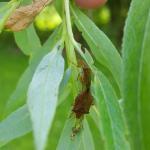 Although stink bugs (Family: Pentatomidae) include many species which feed on plants and can be considered pests, most notably the brown marmorated stink bug or Halyomorpha halys, there are species in this family who make their living as predators. Species which feed on other insects are able to utilize large prey, such as caterpillars or other larvae, by stabbing them with piercing-sucking mouthparts. Some common species of predatory stink bugs are the spined soldier bug (Podisus maculiventris) and the twospotted stink bug (Perillus bioculatus). The mouthparts of predatory stink bugs are connected to the head of the insect such that they can be thrust forward (and into their prey) whereas those who are pests of plants have mouthparts attached such that they can only be directed downward. Two predatory stink bugs can be seen here, mating, while one enjoys a larval-flavored snack. These insects were seen in Chesterfield, MA on willow on 6/2/19.
Although stink bugs (Family: Pentatomidae) include many species which feed on plants and can be considered pests, most notably the brown marmorated stink bug or Halyomorpha halys, there are species in this family who make their living as predators. Species which feed on other insects are able to utilize large prey, such as caterpillars or other larvae, by stabbing them with piercing-sucking mouthparts. Some common species of predatory stink bugs are the spined soldier bug (Podisus maculiventris) and the twospotted stink bug (Perillus bioculatus). The mouthparts of predatory stink bugs are connected to the head of the insect such that they can be thrust forward (and into their prey) whereas those who are pests of plants have mouthparts attached such that they can only be directed downward. Two predatory stink bugs can be seen here, mating, while one enjoys a larval-flavored snack. These insects were seen in Chesterfield, MA on willow on 6/2/19.
Woody ornamental (and other) insect and non-insect arthropod pests to consider, a selected few:
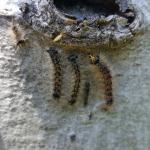 Gypsy Moth:(Lymantria dispar) host plants include but are certainly not limited to oak (favored), maple, birch, poplar, elm, witch hazel, and many others. Gypsy moth caterpillars were again observed on elm and oak in Amherst, MA on 6/3/19. Very few caterpillars were seen in this location actually feeding on leaves. Those that were found on leaves were smaller in size. Third instar caterpillars were again seen resting on areas of the trunk, and this time 4th instar caterpillars were also found resting in these daytime hiding spots. Fourth instar caterpillars have also been collected from apple. During the day, 3rd and 4th instar caterpillars may be seen (if local populations are in relatively low densities) gathered in groups on areas of the trunk or branches. In high populations, this daytime hiding behavior stops and older caterpillars will still be seen feeding on the leaves. Anecdotally, at this time, gypsy moth caterpillar densities on host plant leaves in certain areas, such as parts of Amherst, are still lower than what was expected given the number of overwintering egg masses. While we have had reports of caterpillar activity and feeding across the state, we suspect that an early mortality event (that cannot yet be explained) may have occurred. Dr. Joseph Elkinton and his lab are working with collaborators to see if they can determine what caused this early season mortality. Dr. Elkinton also reports that areas of Amherst are much different this year from what was observed last season (despite some areas having had large numbers of overwintering egg masses). He describes being able to spot at least one caterpillar per leaf on oak in Amherst last year, whereas this season “you really have to hunt for them” in the same locations. While this is certainly excellent news, we should remain cautiously optimistic and continue to monitor gypsy moth populations and feeding damage, particularly in the areas mentioned below in the 2018 overwintering egg mass survey conducted by MA DCR.
Gypsy Moth:(Lymantria dispar) host plants include but are certainly not limited to oak (favored), maple, birch, poplar, elm, witch hazel, and many others. Gypsy moth caterpillars were again observed on elm and oak in Amherst, MA on 6/3/19. Very few caterpillars were seen in this location actually feeding on leaves. Those that were found on leaves were smaller in size. Third instar caterpillars were again seen resting on areas of the trunk, and this time 4th instar caterpillars were also found resting in these daytime hiding spots. Fourth instar caterpillars have also been collected from apple. During the day, 3rd and 4th instar caterpillars may be seen (if local populations are in relatively low densities) gathered in groups on areas of the trunk or branches. In high populations, this daytime hiding behavior stops and older caterpillars will still be seen feeding on the leaves. Anecdotally, at this time, gypsy moth caterpillar densities on host plant leaves in certain areas, such as parts of Amherst, are still lower than what was expected given the number of overwintering egg masses. While we have had reports of caterpillar activity and feeding across the state, we suspect that an early mortality event (that cannot yet be explained) may have occurred. Dr. Joseph Elkinton and his lab are working with collaborators to see if they can determine what caused this early season mortality. Dr. Elkinton also reports that areas of Amherst are much different this year from what was observed last season (despite some areas having had large numbers of overwintering egg masses). He describes being able to spot at least one caterpillar per leaf on oak in Amherst last year, whereas this season “you really have to hunt for them” in the same locations. While this is certainly excellent news, we should remain cautiously optimistic and continue to monitor gypsy moth populations and feeding damage, particularly in the areas mentioned below in the 2018 overwintering egg mass survey conducted by MA DCR.
Gypsy moth caterpillars may be considered in the 4th instar or older when the head capsule becomes yellow in color and mottled with black markings that have been described to look like eye spots. (See photo.) The raised “warts” or bumps on the dorsal or back side of the caterpillar will become the distinctive, familiar colors seen on larger gypsy moth caterpillars. Five pairs of blue warts occur behind the head of the caterpillar, followed by six pairs of red warts or spots. It was recently mentioned to me that a good way to remember the order these colors occur in is to consider the red spots as “taillights” (hence occurring at the rear end of the caterpillar). Once caterpillars reach this size, Btk or Bacillus thuringiensis kurstaki is not as effective as it is on smaller, actively feeding caterpillars.
Despite the fungal outbreak that swept through the 2017 caterpillar population, some lucky caterpillars survived to pupation and emerged as adult moths. (However, adults were present in 2017 in far fewer numbers than would have existed without the fungus.) In 2018, the Massachusetts Department of Conservation and Recreation (DCR) reported that approximately 159,705 acres were defoliated by gypsy moth caterpillars in pockets across the state. While this may seem negligible in comparison to the 923,186 acres of defoliation due to gypsy moth in 2017, for many communities the impact was still significant. MA DCR also surveyed multiple locations across the state for overwintering gypsy moth egg masses in December of 2018. They provide a map of their predictions of where pockets of defoliation may occur in 2019 based on the densities of egg masses they observed in monitored areas across the state. Many of these areas correspond with the locations previously defoliated by gypsy moth caterpillars in 2018. MA DCR predicts gypsy moth activity will occur this season in regionalized pockets of Essex, Hampden, Hampshire, Middlesex, Norfolk, Plymouth, and Worcester Counties. Maps of previous year’s defoliation as well as the 2018 overwintering gypsy moth egg mass survey may be found courtesy of the MA DCR here: https://www.mass.gov/guides/gypsy-moth-in-massachusetts .
While it is very difficult to predict how much defoliation Massachusetts will see in 2019 due to gypsy moth caterpillar feeding, it is possible that in areas where many egg masses overwintered, pockets of defoliation could still occur in certain areas of the state this year.
- Winter Moth: (Operophtera brumata) the winter moth population in eastern Massachusetts continues to be at record lows in most locations, and Dr. Joseph Elkinton, Professor of Environmental Conservation at the University of Massachusetts is declaring victory over this pest! In case you have missed this news from last year, a recent edition of the UMass Magazine discusses the winter moth story and successes with the biological control of this insect (along with some fun and excellent illustrations): https://www.umass.edu/magazine/spring-2019/winter-moth .
See the Regional Reports above for current updates. Pupation of winter moth caterpillars typically occurs in late May/early June in Massachusetts, depending upon the location. Coastal areas including Cape Cod are usually a week or two behind more inland locations. Upon maturity, winter moth caterpillars will be approximately one inch in length and drop to the soil to pupate. Once pupation occurs, management of winter moth is no longer feasible.
Be sure that management of winter moth is necessary by monitoring for damaging populations before making applications in landscape settings. There may be some locations where winter moth caterpillars can be found while Cyzenis albicans catches up with the population. For more information about the life cycle and management of winter moth, please visit this fact sheet: Winter Moth Identification and Management ( https://ag.umass.edu/landscape/fact-sheets/winter-moth-identification-management ).
Winter moth is a non-native insect that was identified in Massachusetts for the first time in 2003 following persistent reports of defoliation in eastern areas of the state such as Cape Anne and on the North Shore near Cohasset, Hingham, and Rockland on the South Shore in the late 1990’s. For more detailed information about the history of this insect pest in North America and Massachusetts, please visit this fact sheet: Winter Moth in Massachusetts: History and Biological Control ( https://ag.umass.edu/landscape/fact-sheets/winter-moth-in-massachusetts-history-biological-control ).
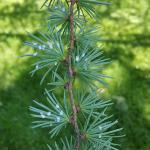
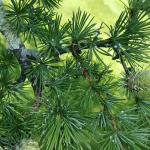 Adelgids of Larch: There are at least two species of adelgid that feed alternatively on larch and spruce. Both have a late spring generation on larch. In this particular case, a species of adelgid was observed on Japanese larch (Larix kaempferi) on 6/3/2019 in Amherst, MA. Two species that occur on larch in New England are both in the genus Adelges. A. lariciatus and A. laricis. Of the two, A. laricis has been recorded on Japanese larch, so the assumption is that is the species we have here. However, conservatively, an identification to genus in this case is likely more appropriate. The late spring generation of these adelgids on larch can be impressive. The population may be so high, the tree may appear as if dusted with snow. In the case of this observation, females with a white, powdery wax covering their otherwise dark, nearly black bodies can be seen beneath a dissecting microscope, surrounded by clusters of eggs. Young nymphs were also observed to have hatched from a sample collected on 6/3/19 and feeding on the needles. The nymphs, to the naked eye, look like tiny black specks found on the needles.
Adelgids of Larch: There are at least two species of adelgid that feed alternatively on larch and spruce. Both have a late spring generation on larch. In this particular case, a species of adelgid was observed on Japanese larch (Larix kaempferi) on 6/3/2019 in Amherst, MA. Two species that occur on larch in New England are both in the genus Adelges. A. lariciatus and A. laricis. Of the two, A. laricis has been recorded on Japanese larch, so the assumption is that is the species we have here. However, conservatively, an identification to genus in this case is likely more appropriate. The late spring generation of these adelgids on larch can be impressive. The population may be so high, the tree may appear as if dusted with snow. In the case of this observation, females with a white, powdery wax covering their otherwise dark, nearly black bodies can be seen beneath a dissecting microscope, surrounded by clusters of eggs. Young nymphs were also observed to have hatched from a sample collected on 6/3/19 and feeding on the needles. The nymphs, to the naked eye, look like tiny black specks found on the needles.
- Asian Longhorned Beetle: (Anoplophora glabripennis, ALB) Look for signs of an ALB infestation which include perfectly round exit holes (about the size of a dime), shallow oval or round scars in the bark where a female has chewed an egg site, or sawdust-like frass (excrement) on the ground nearby host trees or caught in between branches. Be advised that other, native insects may create perfectly round exit holes or sawdust-like frass, which can be confused with signs of ALB activity.
The regulated area for Asian longhorned beetle is 110 miles2 encompassing Worcester, Shrewsbury, Boylston, West Boylston, and parts of Holden and Auburn. If you believe you have seen damage caused by this insect, such as exit holes or egg sites, on susceptible host trees like maple, please call the Asian Longhorned Beetle Eradication Program office in Worcester, MA at 508-852-8090 or toll free at 1-866-702-9938.
To report an Asian longhorned beetle find online or compare it to common insect look-alikes, visit: http://massnrc.org/pests/albreport.aspx or https://www.aphis.usda.gov/pests-diseases/alb/report .
- Boxwood Psyllid: Cacopsylla buxi produces cupping of the leaves of American boxwood. Nymphs, covered in long threads of wax, feed on newly developing leaves in the spring. As the cupped leaves form, nymphs are protected from horticultural oil and insecticidal soap applications. Nymphs use these sheltered areas to continue feeding until late May and early June. One generation occurs per year. Adults lay the overwintering eggs near bud scales in the early summer. Most Buxus sempervirens cultivars are preferred and thus damaged, whereas English boxwoods rarely are damaged by the psyllid. However, the injury caused by this insect is primarily aesthetic. It is not typically as damaging as injury caused by the boxwood leafminer (Monarthropalpus flavus), the adult flies of which typically emerge in late May to early June between roughly 300-650 GDD’s. Eggs are laid in the upper side of the current season’s leaves and hatch in roughly 3 weeks. Larvae feed within the leaves, which may become yellow and spotted and drop prematurely. Over multiple seasons, twig dieback may occur. Partially grown larvae overwinter. This insect attacks most cultivars of Buxus sempervirens and B. microphylla. Buxus sempervirens ‘Vardar Valley’ is considered to be resistant to the boxwood leafminer.
- Deer Tick/Blacklegged Tick: Check out the archived FREE TickTalk with TickReport webinars available here:https://ag.umass.edu/landscape/education-events/webinars . The next live webinar will be held on October 9, 2019 with Dr. Stephen Rich of the UMass Laboratory of Medical Zoology. Previous webinars including information about deer ticks and associated diseases, American dog ticks and lone star ticks and associated diseases, ticks and personal protection, and updates from the Laboratory of Medical Zoology are archived at the link above.
Deer tick (Ixodes scapularis) nymphs (immatures) are active at this time, and may be encountered now through August. For images of all deer tick life stages, along with an outline of the diseases they carry, visit: http://www.tickencounter.org/tick_identification/deer_tick .
Anyone working in the yard and garden should be aware that there is the potential to encounter deer ticks. The deer tick or blacklegged tick can transmit Lyme disease, human babesiosis, human anaplasmosis, and other diseases. Preventative activities, such as daily tick checks, wearing appropriate clothing, and permethrin treatments for clothing (according to label instructions) can aid in reducing the risk that a tick will become attached to your body. If a tick cannot attach and feed, it will not transmit disease. For more information about personal protective measures, visit: http://www.tickencounter.org/prevention/protect_yourself .
Have you just removed an attached tick from yourself or a loved one with a pair of tweezers? If so, consider sending the tick to the UMass Laboratory of Medical Zoology to be tested for disease causing pathogens. To submit a tick to be tested, visit: https://www.tickreport.com/ and click on the blue “Order a TickReport” button. Results are typically available within 3 business days, or less. By the time you make an appointment with your physician following the tick attachment, you may have the results back from TickReport to bring to your physician to aid in a conversation about risk.
The UMass Laboratory of Medical Zoology does not give medical advice, nor are the results of their tests diagnostic of human disease. Transmission of a pathogen from the tick to you is dependent upon how long the tick had been feeding, and each pathogen has its own transmission time. TickReport is an excellent measure of exposure risk for the tick (or ticks) that you send in to be tested. Feel free to print out and share your TickReport with your healthcare provider.
- Eastern Tent Caterpillar: Malacosoma americanum caterpillars will finish their feeding and tent construction this month. Adult moths typically appear by the end of June to early July. Susceptible hosts include cherry and crabapple. Other host plants whose leaves are fed upon by this insect can include apple, ash, birch, willow, maple, oak, poplar, and witch-hazel. Eastern tent caterpillars are native to Massachusetts and have many associated natural enemies (parasites and predators) that help regulate populations. Unless these caterpillars are actively defoliating specimen trees in a landscaped setting, we can coexist with this particular herbivore native to our forests.
- Elongate Hemlock Scale: Fiorinia externa is found on eastern, Carolina, and Japanese hemlock, as well as yew, spruce, and fir. Overlap of many developmental stages at any given time can be observed. Treatments for the crawler, or mobile, stage of this insect may be made in late May through mid-June, or between 360-700 GDD’s, base 50°F.
- Emerald Ash Borer: (Agrilus planipennis, EAB) Thus far in 2019, the Massachusetts Department of Conservation and Recreation has confirmed 26 new community detections of emerald ash borer in Massachusetts. While the cities and towns with recent detections of EAB are too numerous to list here, they are in areas of Berkshire, Hampden, Hampshire, Middlesex, and Worcester counties. A map of these locations and others previously known across the state may be found here: https://ag.umass.edu/fact-sheets/emerald-ash-borer .
This wood-boring beetle readily attacks ash (Fraxinus spp.) including white, green, and black ash and has also been found developing in white fringe tree (Chionanthus virginicus) and has been reported in cultivated olive (Olea europaea). Adult insects of this species will not be present at this time of year. Signs of an EAB infested tree may include (at this time) D-shaped exit holes in the bark (from adult emergence in previous years), “blonding” or lighter coloration of the ash bark from woodpecker feeding (chipping away of the bark as they search for larvae beneath), and serpentine galleries visible through splits in the bark, from larval feeding beneath. Positive identification of an EAB-infested tree may not be possible with these signs individually on their own.
For further information about this insect, please visit: https://ag.umass.edu/fact-sheets/emerald-ash-borer . If you believe you have located EAB-infested ash trees, particularly in an area of Massachusetts not identified on the map provided, please report here: http://massnrc.org/pests/pestreports.htm .
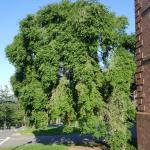

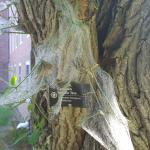 Euonymus Caterpillar: Yponomeuta cagnagella is of European origin and widespread in distribution throughout Europe. It was first reported in North America in Ontario in 1967. Euonymus caterpillars continue to feed and grow in size on European spindle tree foliage in Amherst, MA as observed on 6/3/2019. Caterpillars can be seen webbing foliage together, feeding, and packing that webbing full of their tiny, black frass pellets. As these caterpillars grow in size, so do their webs and entire branches may become defoliated or unsightly. At this particular location, webs are growing so large in size that entire branches and an expanding portion of the canopy is covered. On 6/3/19, groups of caterpillars were also seen dropping from the canopy on strands of webbing.
Euonymus Caterpillar: Yponomeuta cagnagella is of European origin and widespread in distribution throughout Europe. It was first reported in North America in Ontario in 1967. Euonymus caterpillars continue to feed and grow in size on European spindle tree foliage in Amherst, MA as observed on 6/3/2019. Caterpillars can be seen webbing foliage together, feeding, and packing that webbing full of their tiny, black frass pellets. As these caterpillars grow in size, so do their webs and entire branches may become defoliated or unsightly. At this particular location, webs are growing so large in size that entire branches and an expanding portion of the canopy is covered. On 6/3/19, groups of caterpillars were also seen dropping from the canopy on strands of webbing.
The euonymus caterpillars (larvae) feed in groups and envelop the foliage of the host plant in webs as they feed. Hosts include: Euonymus europaeus (tree form), E. kiautschovicus, E. alatus, and E. japonicus. Mature caterpillars are just under an inch in length, creamy yellow-gray in color with black spots and a black head capsule. By late June, these larvae pupate in white, oval-shaped cocoons which are typically oriented together vertically either on host plants or non-hosts in the area. Cocoons can be found in cracks and crevices, or webbed together leaves. The adult moth emerges in late June in most locations. The adult female secretes a gummy substance over her eggs which will harden, making them even more difficult to see. Eggs hatch by mid-August, at which time the tiny larvae prepare to overwinter beneath their eggshell-like covering. These larvae are inactive until the following year, when caterpillars group together to feed on newly emerging leaves, creating a mess of webs as they feed. There is one generation per year. Plants may be partially or entirely defoliated. Management of young, actively feeding caterpillars with Bacillus thuringiensis is possible if deemed necessary, however many species of Euonymus are considered invasive themselves.
 Forest Tent Caterpillar: Malacosoma disstria caterpillars were observed wandering on oak in Amherst, MA on 6/3/19. Forest tent caterpillars are hairy, with black and blue coloration in addition to white, “key-hole” shaped markings along the dorsal side of the caterpillar. (Some also describe these markings as looking like little penguins.) Susceptible hosts whose leaves are fed on by this insect include oak, birch, ash, maple, elm, poplar, and basswood. Pupation should be occurring soon, as this species typically does so by mid-late spring in Massachusetts with the appearance of adult moths occurring shortly thereafter. However, at this time, caterpillars are still observed in the landscape.
Forest Tent Caterpillar: Malacosoma disstria caterpillars were observed wandering on oak in Amherst, MA on 6/3/19. Forest tent caterpillars are hairy, with black and blue coloration in addition to white, “key-hole” shaped markings along the dorsal side of the caterpillar. (Some also describe these markings as looking like little penguins.) Susceptible hosts whose leaves are fed on by this insect include oak, birch, ash, maple, elm, poplar, and basswood. Pupation should be occurring soon, as this species typically does so by mid-late spring in Massachusetts with the appearance of adult moths occurring shortly thereafter. However, at this time, caterpillars are still observed in the landscape.
- Hemlock Looper: Two species of geometrid moths in the genus Lambdina are native insects capable of defoliating eastern hemlock, balsam fir, and white spruce. Adult moths lay their eggs on the trunk and limbs of hosts in September and October, and eggs will hatch by late May or early June. Monitor susceptible hosts for small, inch-worm like caterpillars. Where populations are low, no management is necessary.
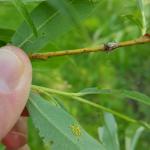
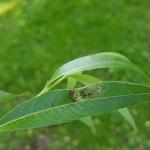 Imported Willow Leaf Beetle: Plagiodera versicolora adult beetles overwinter near susceptible hosts. A few adult imported willow leaf beetles were seen feeding on willow foliage in Chesterfield, MA on 5/11/19 and no mating or egg laying was seen at the time.By 5/22/19, it was very easy to spot adult imported willow leaf beetles feeding and mating, as well as the damage they cause to the leaves. Egg laying was also observed on 5/22/19. On 5/29/19, feeding adult beetles and clusters of eggs were still observed. No larvae were yet seen at this particular location at that time. However, by 6/2/19, clusters of eggs hatched and tiny, feeding imported willow leaf beetle larvae could be seen. These yellow-ish larvae skeletonize the leaf in groups. See Regional Reports above for further updates. Larvae are slug-like and bluish-green to yellow in color. They will feed in clusters and skeletonize the leaves. Most plants can tolerate the feeding from this insect, and foliage will appear brown. Repeated yearly feeding can be an issue, in which case management of the young larvae may be necessary. Take care with treatment in areas near water.
Imported Willow Leaf Beetle: Plagiodera versicolora adult beetles overwinter near susceptible hosts. A few adult imported willow leaf beetles were seen feeding on willow foliage in Chesterfield, MA on 5/11/19 and no mating or egg laying was seen at the time.By 5/22/19, it was very easy to spot adult imported willow leaf beetles feeding and mating, as well as the damage they cause to the leaves. Egg laying was also observed on 5/22/19. On 5/29/19, feeding adult beetles and clusters of eggs were still observed. No larvae were yet seen at this particular location at that time. However, by 6/2/19, clusters of eggs hatched and tiny, feeding imported willow leaf beetle larvae could be seen. These yellow-ish larvae skeletonize the leaf in groups. See Regional Reports above for further updates. Larvae are slug-like and bluish-green to yellow in color. They will feed in clusters and skeletonize the leaves. Most plants can tolerate the feeding from this insect, and foliage will appear brown. Repeated yearly feeding can be an issue, in which case management of the young larvae may be necessary. Take care with treatment in areas near water.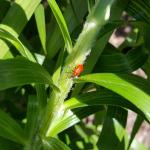
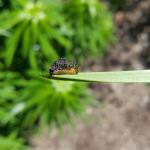
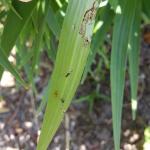 Lily Leaf Beetle: Lilioceris lilii adults overwintered in sheltered places. Although adult beetles were not seen during the chilly weather on 5/13/19 in Amherst, MA, previously laid eggs were found on host plant foliage in this location. As of 5/21/19, egg hatch had occurred and larvae of various sizes could be seen feeding on foliage in groups. Smaller larvae skeletonize leaves, whereas larger larvae can eat the entire leaf.By 5/30/19, large lily leaf beetle larvae were observed eating entire leaves. Conditions were also favorable to see adults mating, and eggs could also still be found at this location on 5/30. On 6/3/19, adult lily leaf beetles, eggs, and larvae of various sizes were still seen on host plants. Susceptible hosts include Lilium spp. (Turk’s cap, tiger, Easter, Asiatic, and Oriental lilies) and Fritillaria spp. (Note: daylilies are not hosts.) Typically, in May, mating will occur and each female will begin to lay 250-450 eggs in neat rows on the underside of the foliage. If there are only a few plants in the garden, hand picking and destroying overwintering adults can help reduce local garden-level populations.
Lily Leaf Beetle: Lilioceris lilii adults overwintered in sheltered places. Although adult beetles were not seen during the chilly weather on 5/13/19 in Amherst, MA, previously laid eggs were found on host plant foliage in this location. As of 5/21/19, egg hatch had occurred and larvae of various sizes could be seen feeding on foliage in groups. Smaller larvae skeletonize leaves, whereas larger larvae can eat the entire leaf.By 5/30/19, large lily leaf beetle larvae were observed eating entire leaves. Conditions were also favorable to see adults mating, and eggs could also still be found at this location on 5/30. On 6/3/19, adult lily leaf beetles, eggs, and larvae of various sizes were still seen on host plants. Susceptible hosts include Lilium spp. (Turk’s cap, tiger, Easter, Asiatic, and Oriental lilies) and Fritillaria spp. (Note: daylilies are not hosts.) Typically, in May, mating will occur and each female will begin to lay 250-450 eggs in neat rows on the underside of the foliage. If there are only a few plants in the garden, hand picking and destroying overwintering adults can help reduce local garden-level populations.
- Spotted Lanternfly: (Lycorma delicatula, SLF) is not known to occur in Massachusetts landscapes (no established populations are known in MA at this time). However, officials with the Massachusetts Department of Agricultural Resources (MDAR) urged residents to check plants for spotted lanternfly. On February 21, 2019 MDAR announced the discovery of a single dead spotted lanternfly adult at a private residence in Boston. As a result of this discovery, officials asked the public to check potted plants they purchase and report any suspicious insects. MDAR reports that this particular individual appeared to have been unintentionally transported this past December in a shipment of poinsettia plants originating from Pennsylvania. Officials also report that there is currently no evidence that this pest has become established in MA. For more information about this finding, please visit the MA Department of Agricultural Resources press release:https://www.mass.gov/news/state-agricultural-officials-urge-residents-to-check-plants-for-spotted-lanternfly .
This insect is a member of the Order Hemiptera (true bugs, cicadas, hoppers, aphids, and others) and the Family Fulgoridae, also known as planthoppers. The spotted lanternfly is a non-native species first detected in the United States in Berks County, Pennsylvania and confirmed on September 22, 2014.
The spotted lanternfly is considered native to China, India, and Vietnam. It has been introduced as a non-native insect to South Korea and Japan, prior to its detection in the United States. In South Korea, it is considered invasive and a pest of grapes and peaches. The spotted lanternfly has been reported from over 70 species of plants, including the following: tree of heaven (Ailanthus altissima) (preferred host), apple (Malus spp.), plum, cherry, peach, apricot (Prunus spp.), grape (Vitis spp.), pine (Pinus spp.), pignut hickory (Carya glabra), sassafras (Sassafras albidum), serviceberry (Amelanchier spp.), slippery elm (Ulmus rubra), tulip poplar (Liriodendron tulipifera), white ash (Fraxinus americana), willow (Salix spp.), American beech (Fagus grandifolia), American linden (Tilia americana), American sycamore (Platanus occidentalis), big-toothed aspen (Populus grandidentata), black birch (Betula lenta), black cherry (Prunus serotina), black gum (Nyssa sylvatica), black walnut (Juglans nigra), dogwood (Cornus spp.), Japanese snowbell (Styrax japonicus), maple (Acer spp.), oak (Quercus spp.), and paper birch (Betula papyrifera).
The adults and immatures of this species damage host plants by feeding on sap from stems, leaves, and the trunks of trees. In the springtime in Pennsylvania (late April - mid-May) nymphs (immatures) are found on smaller plants and vines and new growth of trees and shrubs. Third and fourth instar nymphs migrate to the tree of heaven and are observed feeding on trunks and branches. Trees may be found with sap weeping from the wounds caused by the insect’s feeding. The sugary secretions (excrement) created by this insect may coat the host plant, later leading to the growth of sooty mold. Insects such as wasps, hornets, bees, and ants may also be attracted to the sugary waste created by the lanternflies, or sap weeping from open wounds in the host plant. Host plants have been described as giving off a fermented odor when this insect is present.
Adults are present by the middle of July in Pennsylvania and begin laying eggs by late September and continue laying eggs through late November and even early December in that state. Adults may be found on the trunks of trees such as the tree of heaven or other host plants growing in close proximity to them. Egg masses of this insect are gray in color and, in some ways, look similar to gypsy moth egg masses.
Host plants, bricks, stone, lawn furniture, recreational vehicles, and other smooth surfaces can be inspected for egg masses. Egg masses laid on outdoor residential items such as those listed above may pose the greatest threat for spreading this insect via human aided movement.
For more information about the spotted lanternfly, visit this fact sheet: https://ag.umass.edu/landscape/fact-sheets/spotted-lanternfly
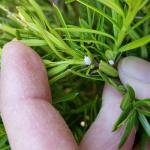 Taxus Mealybug: Dysmicoccus wistariae was spotted on taxus in Amherst on 5/30/19 and again on 6/3/19. This insect will produce honeydew and lead to sooty mold growth, yellowing of needles, and sparsely foliated plants. Eventual dieback may be possible. This species is commonly associated with taxus in New England, but can be occasionally found on dogwood, rhododendron, Prunus spp., maple, andromeda, and crabapple. These mealybugs are found on stems and branches and particularly like to congregate at branch crotches. Management may be targeted between 246-618 GDD’s. Horticultural oil and neem oil may be used according to label instructions.
Taxus Mealybug: Dysmicoccus wistariae was spotted on taxus in Amherst on 5/30/19 and again on 6/3/19. This insect will produce honeydew and lead to sooty mold growth, yellowing of needles, and sparsely foliated plants. Eventual dieback may be possible. This species is commonly associated with taxus in New England, but can be occasionally found on dogwood, rhododendron, Prunus spp., maple, andromeda, and crabapple. These mealybugs are found on stems and branches and particularly like to congregate at branch crotches. Management may be targeted between 246-618 GDD’s. Horticultural oil and neem oil may be used according to label instructions.
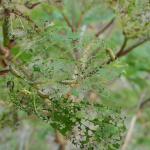
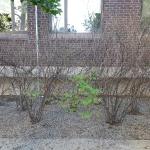 Viburnum Leaf Beetle: Pyrrhalta viburni is a beetle in the family Chrysomelidae that is native to Europe, but was found in Massachusetts in 2004. See Regional Reports above for updates regarding the activity of this pest. In Amherst, MA on 5/29/19 and again on 6/4/19, viburnum leaf beetle larvae were observed causing significant feeding damage on viburnum. The population appears high enough to cause complete defoliation of the shrubs in this location. This beetle feeds exclusively on many different species of viburnum, which includes, but is not limited to, susceptible plants such as V. dentatum, V. nudum, V. opulus, V. propinquum, and V. rafinesquianum. Larvae may be treated with a product containing spinosad. Some viburnum have been observed to have varying levels of resistance to this insect, including but not limited to V. bodnantense, V. carlesii, V. davidii, V. plicatum, V. rhytidophyllum, V. setigerum, and V. sieboldii. More information about viburnum leaf beetle may be found at http://www.hort.cornell.edu/vlb/ .
Viburnum Leaf Beetle: Pyrrhalta viburni is a beetle in the family Chrysomelidae that is native to Europe, but was found in Massachusetts in 2004. See Regional Reports above for updates regarding the activity of this pest. In Amherst, MA on 5/29/19 and again on 6/4/19, viburnum leaf beetle larvae were observed causing significant feeding damage on viburnum. The population appears high enough to cause complete defoliation of the shrubs in this location. This beetle feeds exclusively on many different species of viburnum, which includes, but is not limited to, susceptible plants such as V. dentatum, V. nudum, V. opulus, V. propinquum, and V. rafinesquianum. Larvae may be treated with a product containing spinosad. Some viburnum have been observed to have varying levels of resistance to this insect, including but not limited to V. bodnantense, V. carlesii, V. davidii, V. plicatum, V. rhytidophyllum, V. setigerum, and V. sieboldii. More information about viburnum leaf beetle may be found at http://www.hort.cornell.edu/vlb/ .
- White Spotted Pine Sawyer (WSPS): Monochamus scutellatus adults can emerge now throughout July, depending on local temperatures. This is a native insect in Massachusetts and is usually not a pest. Larvae develop in weakened or recently dead conifers, particularly eastern white pine (Pinus strobus). However, the white spotted pine sawyer looks very similar to the invasive Asian Longhorned Beetle, Anoplophora glabripennis, ALB. ALB adults do not emerge in Massachusetts until July and August. Beginning in July, look for the key difference between WSPS and ALB adults, which is a white spot in the top center of the wing covers (the scutellum) on the back of the beetle. White spotted pine sawyer will have this white spot, whereas Asian longhorned beetle will not. Both insects can have other white spots on the rest of their wing covers; however, the difference in the color of the scutellum is a key characteristic. See the Asian longhorned beetle entry above for more information about that non-native insect.
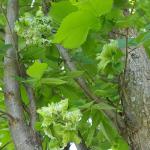 Woolly Apple Aphid: Eriosoma lanigerum may be found on apple, crabapple, hawthorn, mountain-ash, pyracantha, and elm hosts. The primary (winter) host is elm, on which aphids infest emerging spring leaves, causing leaves to curl or close into stunted, rosette-like clusters found at twig tips. Woolly apple aphid was observed on elm on 6/3/2019 in Amherst, MA. Rosettes at this location are full of honeydew producing aphids. On apple and crabapple, this species of aphid colonizes roots, trunks, and branches in the summer and is commonly found near previous wounds or callous tissue. On roots, the aphids cause swelled areas which can girdle and kill roots. The aphids, when found in above ground plant parts such as elm leaves, are covered with white wax. Eggs are the overwintering stage on elm, which hatch in the spring in time for the nymphs to infest new elm foliage. Following a few generations on elm, the aphids will develop into a winged form, which will disperse and seek out apple and crabapple. Multiple generations will occur on these alternate hosts in the summer and by the fall, a winged form will return to elm and mated females will lay eggs near elm buds.
Woolly Apple Aphid: Eriosoma lanigerum may be found on apple, crabapple, hawthorn, mountain-ash, pyracantha, and elm hosts. The primary (winter) host is elm, on which aphids infest emerging spring leaves, causing leaves to curl or close into stunted, rosette-like clusters found at twig tips. Woolly apple aphid was observed on elm on 6/3/2019 in Amherst, MA. Rosettes at this location are full of honeydew producing aphids. On apple and crabapple, this species of aphid colonizes roots, trunks, and branches in the summer and is commonly found near previous wounds or callous tissue. On roots, the aphids cause swelled areas which can girdle and kill roots. The aphids, when found in above ground plant parts such as elm leaves, are covered with white wax. Eggs are the overwintering stage on elm, which hatch in the spring in time for the nymphs to infest new elm foliage. Following a few generations on elm, the aphids will develop into a winged form, which will disperse and seek out apple and crabapple. Multiple generations will occur on these alternate hosts in the summer and by the fall, a winged form will return to elm and mated females will lay eggs near elm buds.
- Woolly Elm Aphid: Eriosoma americanum females lay a single egg in the cracks and crevices of elm bark, where the egg overwinters. Eggs hatch on elm in the spring as leaves are unfolding. A young, wingless female hatched from the egg feeds on the underside of leaf tissue. This female aphid matures and gives birth to 200 young, all females, without mating. These aphids feed, and the elm leaf curls around them and protects them. Curled leaves, due to the activity of the woolly elm aphid, were observed in Amherst, MA on 5/30/19. Opening these curled leaves revealed ample numbers of honeydew producing aphids within.By the end of June, winged migrants mature and find serviceberry hosts. Another set of females is produced. These new females crawl to and begin feeding on the roots of serviceberry. Multiple generations occur on the roots of serviceberry through the summer.
Concerned that you may have found an invasive insect or suspicious damage caused by one? Need to report a pest sighting? If so, please visit the Massachusetts Introduced Pests Outreach Project: http://massnrc.org/pests/pestreports.htm .
A note about Tick Awareness: deer ticks (Ixodes scapularis), the American dog tick (Dermacentor variabilis), and the lone star tick (Amblyomma americanum) are all found throughout Massachusetts. Each can carry their own complement of diseases. Anyone working in tick habitats (wood-line areas, forested areas, and landscaped areas with ground cover) should check themselves regularly for ticks while practicing preventative measures. Have a tick and need it tested? Visit the web page of the UMass Laboratory of Medical Zoology (https://www.tickreport.com/ ) and click on the blue Order a TickReport button for more information.
Reported by Tawny Simisky, Extension Entomologist, UMass Extension Landscape, Nursery, & Urban Forestry Program
Additional Resources
To receive immediate notification when the next Landscape Message update is posted, be sure to join our e-mail list and follow us on Facebook and Twitter.
For a complete listing of upcoming events, see our Upcoming Educational Events page.
For commercial growers of greenhouse crops and flowers - Check out UMass Extension's Greenhouse Update website
For professional turf managers - Check out Turf Management Updates
For home gardeners and garden retailers - Check out home lawn and garden resources. UMass Extension also has a Twitter feed that provides timely, daily gardening tips, sunrise and sunset times to home gardeners, see https://twitter.com/UMassGardenClip
Diagnostic Services
A UMass Laboratory Diagnoses Landscape and Turf Problems - The UMass Extension Plant Diagnostic Lab is available to serve commercial landscape contractors, turf managers, arborists, nurseries and other green industry professionals. It provides woody plant and turf disease analysis, woody plant and turf insect identification, turfgrass identification, weed identification, and offers a report of pest management strategies that are research based, economically sound and environmentally appropriate for the situation. Accurate diagnosis for a turf or landscape problem can often eliminate or reduce the need for pesticide use. For sampling procedures, detailed submission instructions and a list of fees, see Plant Diagnostics Laboratory
Soil and Plant Nutrient Testing - The University of Massachusetts Soil and Plant Nutrient Testing Laboratory is located on the campus of The University of Massachusetts at Amherst. Testing services are available to all. The function of the Soil and Plant Nutrient Testing Laboratory is to provide test results and recommendations that lead to the wise and economical use of soils and soil amendments. For complete information, visit the UMass Soil and Plant Nutrient Testing Laboratory web site. Alternatively, call the lab at (413) 545-2311.
Ticks are active at this time! Remember to take appropriate precautions when working and playing outdoors, and conduct daily tick checks. UMass tests ticks for the presence of Lyme disease and other disease pathogens. Learn more.
